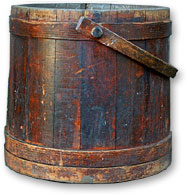Little is known of the part which butter played as an article of commerce in ancient times. In the first centuries butter was shipped from India to ports of the Red Sea. In the 12th century, Scandinavian butter was an article of oversee commerce. The Germans sent ships to Bergen, in Norway, and exchanged their cargoes of wine for butter and dried fish. It is interesting to note that the Scandinavian king considered this practice injurious to his people, and in 1186 compelled the Germans to withdraw their trade. Toward the end of the 13th century, among the enumerated wares of commerce, imported from thirty-four countries into Belgium, Norway was the only one, which included butter. In the 14th century, butter formed an article of export from Sweden. It may be fairly inferred that butter making in north and middle Europe, if not indeed in all Europe, was introduced from Scandinavia.
|
|
Some of the commonest archaeological finds in Ireland are barrels of ancient butter, buried in the bogs. The Norsemen, the Finns, the Icelanders, and the Scots had done the same: they flavored butter heavily with garlic, knuckled it into a wooden firkin, and buried it for years in the bogs‑for so long that people were known to plant trees to mark the butter's burial site. The longer it was left, the more delicious it became. A further advantage was doubtless the safety of supplies from robbers, or enemies in wartime. Most of the Irish archaeological specimens date from the seventeenth and early eighteenth centuries. Although some of our sources imply that bog butter turned red, the firkins in the Irish National Museum contain "a grayish cheese‑like substance, partially hardened, not much like butter, and quite free from putrefaction" because of the cool, antiseptic, anaerobic, and acidic properties of peat bogs.
John Houghton, an Englishman, writing on dairying in 1695, speaks of the Irish as rotting their butter by burying it in bogs. This burying of butter in the peat bogs of Ireland may have been for the purpose of storing against a time of need, to hid it from invaders, or to ripen it for the purpose of developing flavor in a manner similar to cheese ripening.
Archeologists found a deposit of butter buried in peat bogs found wrapped in a skin in County Leitrim, and another packed in a tub with perforated wooden handles in County Tyrone, Ireland. It is believed possible that the practice of burying butter in Ireland ceased about the end of the 18th century and that many of the specimens which have been found are of far greater antiquity (11th to 14th century). The large number of specimens found, some of which weighed over 100 pounds, suggests that the burying of butter must have been a widespread practice in Ireland. Similar deposits of buried butter were also discovered in Finland.
Various other methods of packaging butter have been found mentioned in a variety of sources. A news item in the December 4, 1907 issue of the New York Produce Review and American Creamery tells of a traveler in Central Africa in 1872 being offered butter wrapped in leaves and then covered with a layer of cow dung which upon drying kept air from the butter. Repeated references are found in the literature of instances where pats of butter are cited as being "wrapped in cool cabbage leaves or freshly cut grass" -- a practice, which appeared to be rather common in various parts of Europe. As a matter of fact, it was a common practice in the earlier days of the South Water Street market in Chicago, for farmers to refrigerate their shipments of butter transported in open wagons by covering the same with grass freshly cut while still wet with dew.

